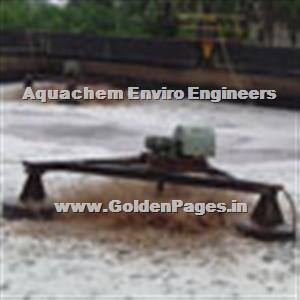AQUACHEM ENVIRO ENGINEERSP.LTD
Featured Products
Highest quality standards are achieved through the implementations of latest technology, decades of experience and everlasting moral values , which have helped us to retain our customers as well as multiply them.
Welcome to AQUACHEM ENVIRO ENGINEERSP.LTD
Activated Sludge Process

Activated Sludge Process
Activated Sludge Process is the most commonly used process for biological treatment of waste. The tank is designed such that the waste-water with the micro-organisms are continuously aerated & kept in suspension. The sludge from the down-stream clarification system is recycled back to the aeration tank. The sludge which is wasted partially is digested sludge and separate sludge digestor is not required. This process is capable of taking shock loads.
Extended Aeration Process
Extended Aeration Process is used for biological treatment when the waste-water is intense or concentrated. This process is capable of taking shock loads. This process gives low bio-solids production with well stabilized sludge. Also, high quality effluent can be treated in this process.
Two-stage Activated Sludge Process (or Multi-stage)
Two-stage Activated Process is used for biological treatment when the waste-water is intense or concentrated. This process consists of an aeration tank and clarifier system repeated twice in series. For the same reactor volume, reactors in series provide greater treatment efficiency than a single complete mix reactor with greater treatment efficiency for certain wastewaters. It ensures better organic removals for effluents with higher COD: BOD ratio. This process is capable of taking shock loads. This process gives low bio-solids production with well stabilized sludge. Also, high quality effluent can be treated in this process.
Submerged Aerobic Fixed Film Process
Submerged Aerobic Fixed Film Process employs submerged media to which micro-organisms attach themselves. The biomass retained on the surfaces of the media provides the required treatment of organic matter. The media is kept in fixed state by fixing at intermittent level submerged. Coarse bubble aeration is preferred for aeration in case of SAFF process. As it is an attached growth process, no sludge recycling is required in the SAFF reactor.
Fluidized Aerobic Systems
The Fluidized Aerobic Systems incorporates fluidized media in the aeration tank to provide surface area for micro-organisms to attach themselves. In this process, thin bio-films are produced and there is minimal solids capture. This process works best for wastewaters with mainly soluble organics. This system is able to provide high biomass concentrations with high organic loadings, and is able to absorb shock loads due to turbulent mixing and recycle.
Moving Bed Bio-Reactor Systems
Moving Bed Bio-Reactor Systems employ small suspended media in the aeration tank to provide surface area for micro-organisms to attach themselves. In this process, bio-films are produced on the surface of such suspended media. As it is an attached growth process, no sludge recycling is required in the MBBR reactor.
Anaerobic Systems
Anaerobic Systems are significant in the treatment methodology for high strength wastewaters and also for warm wastewaters. This process involves biological degradation in the absence of oxygen thus reducing aeration cost. Anaerobic processes are capable of adapting easily to intermittent wastewater feeds. One of the by-products of the anaerobic system is production of methane gas, which if substantial in volume, can be used as fuel. The Upflow-Anaerobic Sludge Blanket Reactor or UASBR is consists of effluent distribution system, gas-liquid-solids separation system and gas collection system. The advantage of UASBR is the ability to handle high loadings with relatively low detention times.
Membrane Bio-Reactor Systems
Membrane Bio-Reactor Systems consist of suspended growth aeration process and solids separation by micro-filtration membranes. The membrane system produces a treated effluent of quality equal effluent obtained by conventional method by secondary clarification followed by tertiary microfiltration. This process is able to handle high volumetric loadings thus reducing the foot-print of the plant, longer SRTs, thus reducing sludge generation and high-quality treated effluent.
Sequential Batch Reactor Systems
The Sequential Batch Reactor Systems involve a fill-and-draw type system for a reactor with complete mixing taking place during batch reaction step with subsequent aeration & clarification occurring in the same reactor. A unique feature of SBR Process is that no sludge recycle is required.
Zero Discharge Systems / Recycle & Reuse
Zero Discharge Systems incorporate the use of Reverse Osmosis System for final treatment to the treated wastewater. As rules for disposal of treated effluent is becoming more and more stringent, one of the urgent needs is to treat the effluent to such an extent so that it can be recycled and then reused back in process itself. The RO System involves the use of thin-film composite membranes which allow passage of only water along with sodium and chloride ions, rejecting all other ions, molecules etc of size > 0.0001 µm. The RO system gives two streams – one is Permeate which is very pure and can be reused back in process; the other is Reject which has to be suitably disposed either by Multiple Effect Evaporator System (MEE) or Solar Pond Evaporation (SEP). The distillate from MEE is recycled back to ETP and the salts are sent to landfill. This ensures a completely “Zero-Discharge” system in terms of water.
Specific Pollutant Removal
Certain wastewaters from Ammonia
Chromium
Metals
Our Vision
* To embrace new technologies and methods. * To give unsurpassed products and services to the clients. * To constantly look for improvement and changes.










